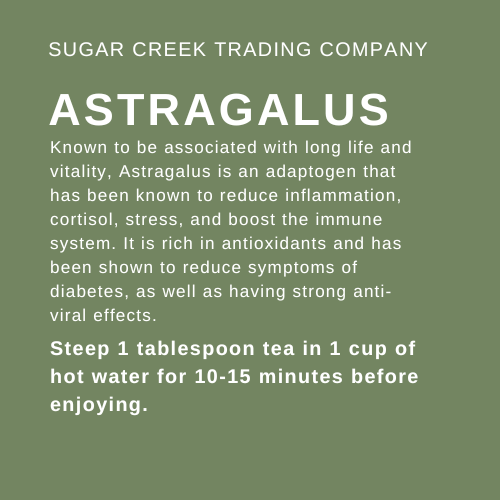Sugar Creek Trading Company
Astragalus
Astragalus
Impossible de charger la disponibilité du service de retrait
ASTRAGALUS MEMBRANACEUS (HUANG QI)
The Qi Tonic—An Asian Root for Immunity, Vitality, and Adaptation
BOTANICAL IDENTIFICATION
Scientific Name: Astragalus membranaceus (Fisch.) Bunge
Synonym: Astragalus propinquus Schischkin
Common Names: Huang Qi, Milk Vetch Root, Yellow Leader
Family: Fabaceae
Astragalus membranaceus is a perennial herbaceous plant growing 30–100 centimeters tall. It features pinnate compound leaves with numerous leaflets and pale yellow papilionaceous flowers. The root is thick, fibrous, and yellowish-brown, harvested at 4–6 years of age for medicinal use.
Native to northern China, Mongolia, and parts of Siberia. Prefers dry slopes, grasslands, and forest edges in temperate climates.
Adaptations include nitrogen-fixing root nodules and drought tolerance.
CULTURAL AND HISTORICAL USE
Astragalus membranaceus has been used in Traditional Chinese Medicine (TCM) for over 2,000 years as a foundational Qi tonic.
Known as Huang Qi, it is used to strengthen Wei Qi (defensive energy), improve vitality, and support recovery from chronic illness.
It is also a key ingredient in classic formulas like Yu Ping Feng San for immune strengthening and fatigue reduction.
KEY BIOACTIVE COMPOUNDS AND BENEFITS
| Compound | Role in Plant | Human Benefits | Regional Variation |
|---|---|---|---|
| Astragalosides (I-IV) | Saponins | Immune modulation, cellular repair | Highest in Chinese cultivated roots |
| Isoflavonoids | Phytoestrogens | Antioxidant, cardiovascular support | Variable by growing region |
| Polysaccharides | Storage carbohydrates | Enhance macrophage and T-cell activity | Abundant across all ecotypes |
| Trace Minerals (Selenium, Zinc) | Nutrient accumulation | Support antioxidant enzymes | Concentrations vary by soil |
These compounds promote immune resilience, protect against oxidative stress, and enhance cellular energy.
HOW IT WORKS IN THE BODY
Astragalosides and polysaccharides stimulate immune cells including macrophages, dendritic cells, and natural killer cells.
Polysaccharides activate the complement system and increase interferon production.
Isoflavonoids provide antioxidant and cardioprotective effects, while saponins support telomere integrity and mitochondrial function.
Clinical studies show Astragalus extract enhances immune response in chronic fatigue, viral infections, and as adjunctive support in chemotherapy.
DOSE GUIDELINES
| Preparation Type | Typical Dose | Purpose |
|---|---|---|
| Dried Root (Decoction) | 9–30 grams daily | Immune support, energy tonic |
| Tincture (1:5) | 3–6 milliliters up to three times daily | Chronic immune deficiency, fatigue |
| Standardized Extract | 500–1,500 milligrams daily | Adaptogen and cellular defense |
Long-term use is common in traditional practice for gradual tonic effects.
PREPARATION AND USES
Traditionally decocted in soups or teas, combined with other tonic herbs such as ginseng and licorice.
Modern preparations include standardized extracts, capsules, and immune-support formulas.
Also used in topical preparations for wound healing in traditional contexts.
OPTIMAL CONTEXT FOR USE
Beneficial for individuals recovering from chronic illness, undergoing stress, or seeking to strengthen immune defenses.
Northern Chinese cultivated roots are the pharmacopoeial standard for highest astragaloside content.
Safe for adults in long-term use as a tonic; appropriate for seasonal immune support.
SUSTAINABILITY AND ETHICAL HARVESTING
Astragalus membranaceus is widely cultivated in China, reducing pressure on wild populations.
Sustainable practices include crop rotation and organic soil enrichment.
Ethical sourcing ensures support for traditional farming communities in Northern China.
SAFETY AND CAUTIONS
Generally regarded as safe.
Not recommended during acute infections with fever due to its Qi-tonifying nature in TCM.
May interact with immunosuppressive medications by enhancing immune activity.
Rare side effects include mild digestive upset or allergic reactions in sensitive individuals.
REFERENCES
Bensky D, Clavey S, Stöger E. (2004). Chinese Herbal Medicine: Materia Medica.
Cho WC, Leung KN. (2007). Astragalus membranaceus in cancer chemotherapy: Effects and mechanisms. PMID 17465525.
European Medicines Agency (2016). Astragalus root monograph.
Traditional Chinese Pharmacopoeia (2020 Edition).
FINAL NOTE
Astragalus membranaceus is a root of quiet strength. Through centuries of tonic use, it has fortified the immune system and restored vitality. In its golden fibers lies the ancient wisdom of balance and resilience.
Share

